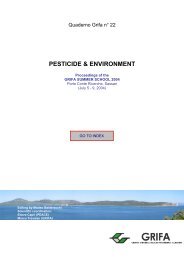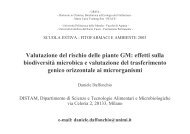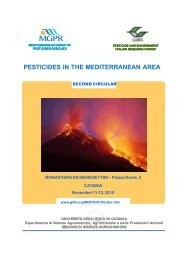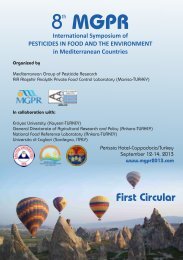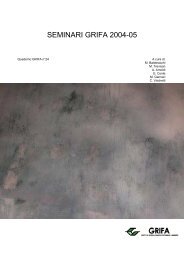International Congress BIOLOGICAL PRODUCTS - Gruppo di ...
International Congress BIOLOGICAL PRODUCTS - Gruppo di ...
International Congress BIOLOGICAL PRODUCTS - Gruppo di ...
Create successful ePaper yourself
Turn your PDF publications into a flip-book with our unique Google optimized e-Paper software.
23<br />
CHARACTERIZATION OF ORGANIC VIRGIN OLIVE OILS FROM CORATINA CULTIVAR<br />
E. Perri, N. Lombardo, I. Muzzalupo, E. Urso, M.<br />
Pellegrino<br />
Istituto Sperimentale per l’Olivicoltura<br />
C.da Li Rocchi, 87036 Rende (CS), Italy<br />
eperri@libero.it<br />
G. Sindona, C. Benincasa<br />
Dipartimento <strong>di</strong> Chimica<br />
Università della Calabria<br />
I-87030 Arcavacata <strong>di</strong> Rende (CS), Italy<br />
119<br />
C. Cavallo<br />
Regione Puglia<br />
I.P.A., Brin<strong>di</strong>si, Italy<br />
Introduction<br />
In spite of the growing interest in organically cultivated olive grove and organic olive oil in European and<br />
international markets, there are very few reports on the qualitative, nutritional and organoleptic characteristics of<br />
these products (Gutierrez et al., 1999; Perri et al., 1999; Perri et al., 2001; Perri et al., 2002). Recently, a<br />
research project dealing with the “Characterisation of olive oils from the South of Italy obtained by organic<br />
farming systems” has been co-funded by the EU and the Italian Ministry of Agriculture (B07 Project,<br />
Multiregional Operational Programme, 2 Measure). The principal aim of this research project was to classify and<br />
characterise the nutritional and organoleptic quality of organic olive oils and to compare the quality of organic<br />
olive oil of important Italian cultivars from selected producing areas to conventional and/or integrated olive oils<br />
from the same cultivars and areas. This paper presents some results of the second year of activity in Apulia of the<br />
above research project.<br />
Materials and methods<br />
Plant material. In 2000, triplicate samples of organically and integrated cultivated olive drupes of Coratina cv<br />
from two adjacent farms at Andria (Bari, Italy) were collected 10 days before the tra<strong>di</strong>tional start of harvest, in<br />
the middle of the harvest period and 10 days after the end of harvest time. To compare organically produced<br />
olive oils versus integrated olive oils the olives were handpicked from the same cultivars under comparable<br />
pedo-climatic, harvesting and productive con<strong>di</strong>tions and the analytical and sensory data compared on the basis of<br />
the same stage of olive maturity monitored by Jaen index (Gutierrez et al., 1999).<br />
Work-up of plant material. Olive drupes (10 Kg) were crushed with a hammer mill and the oil was extracted by<br />
centrifugation after 20 minutes of malaxation at RT.<br />
Analytical procedures. The measurements of free aci<strong>di</strong>ty, fatty acid methyl esters, peroxide index, specific<br />
extinction coefficients K232 and K270, ∆k, and panel test have been determined accor<strong>di</strong>ng to the European Official<br />
Methods of Analysis (EC Regulation N. 2568/91 July, 1991). Total phenols were determined by colorimetry<br />
using the Folin-Ciocalteu reagent using caffeic acid as external standard. Oleuropein (olp) was determined in<br />
virgin olive oil extracts by tandem mass spectrometry with Atmospheric Pressure Chemical Ionization (APCI-<br />
MS/MS) under Selected Reaction Monitoring (SRM) con<strong>di</strong>tion (Perri et al., 1999b).<br />
Results and <strong>di</strong>scussion<br />
The analytical data arising from the second year of sampling confirm the preliminary results published on the<br />
first paper (Perri et al., 2002): i) olive oil from Coratina cv. is characterised by high level of total phenols and<br />
high percentages of oleic acid in a wide range of stages of maturity of the drupes; ii) all the examined olive oil<br />
samples were ascribable to the extra virgin olive oil grade on the basis of analytical data relating to free aci<strong>di</strong>ty,<br />
peroxide number, specific extinction coefficients K232 and K270 , ∆k, fatty acid methyl esters, sterol and<br />
organoleptic score (panel test); iii) ecologically grown olives can produce high-quality oil thanks to the low<br />
Bactrocera oleae infestations; iv) as shown by the variance analysis (table 1), analytical and sensory data<br />
relating to organic and integrated olive oils are very similar. In fact, the only statistical significant <strong>di</strong>fference<br />
observed between organic and integrated olive oils correspon<strong>di</strong>ng to the means of the sensory score of integrated<br />
olive oil (table 1) may be considered negligible from the quality point of view.<br />
Acknowledgements<br />
The Italian Ministry of Agriculture and European Union (Multiregional Operational Programme, Measure 2, B07<br />
Project) supported this research work. We thank Dr. Nino Paparella, Dr. Nicola Panaro (C.I.Bi., Bari) and Drs.<br />
Edoardo and Giancarlo Ceci Ginistrelli for olive sampling, data collection on farming systems and olive grove<br />
management. We thank also Prof. Angelo Putignano and Prof. Francesco Prudentino (I.T.A.S. of Ostuni-BR) for<br />
olive oil extraction.<br />
Literature cited<br />
Gutierrez R. F., Arnaud T., Albi M., Influence of ecological cultivation on virgin olive oil quality, JAOCS, 1999,<br />
76:617-621.<br />
PDF creato con FinePrint pdfFactory versione <strong>di</strong>mostrativa http://www.secom.re.it/fineprint



